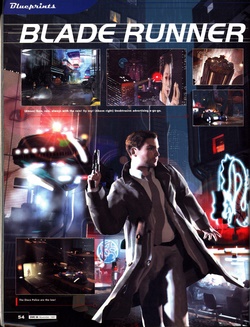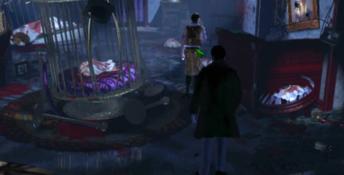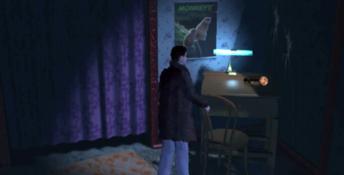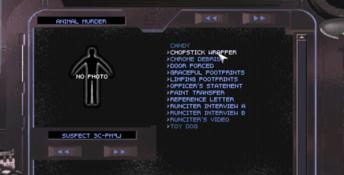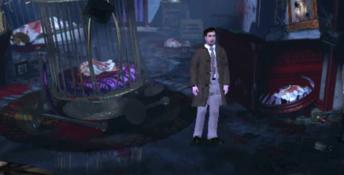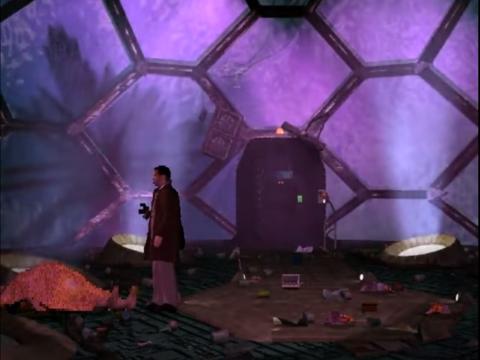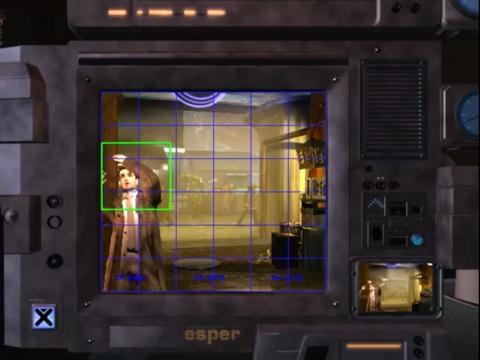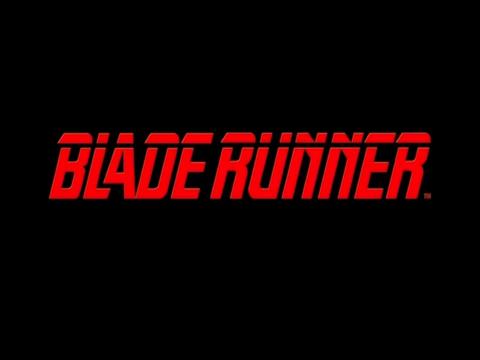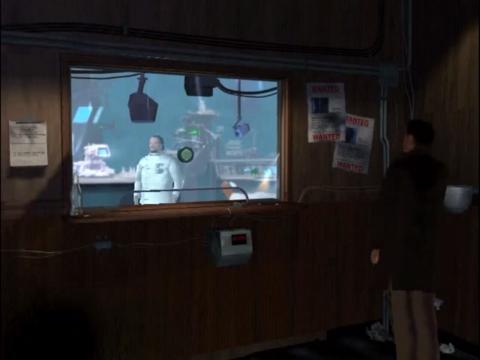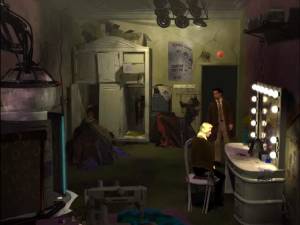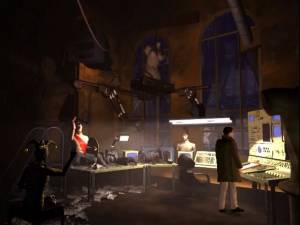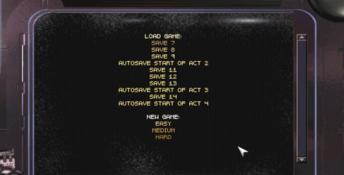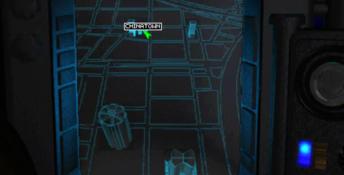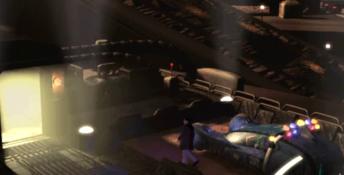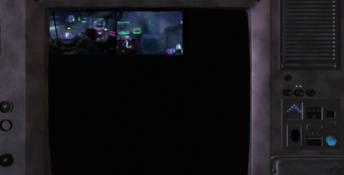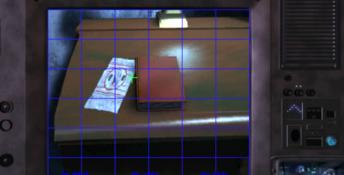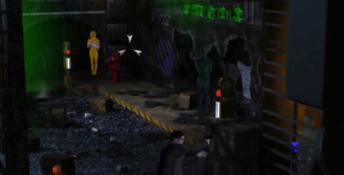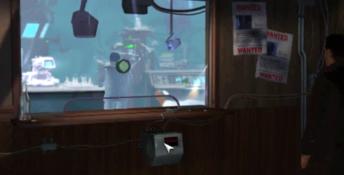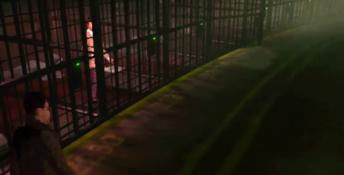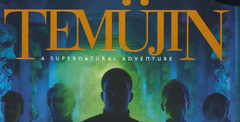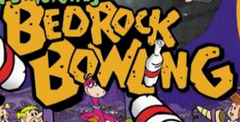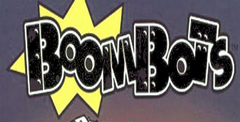Blade Runner

| a game by | Southpeak Interactive |
| Platform: | PC |
| Editor Rating: | 5/10, based on 3 reviews, 4 reviews are shown |
| User Rating: | 8.2/10 - 9 votes |
| Rate this game: | |
| See also: | Mystery Games, Quest Games, Best Detective Games |
Blade Runner is Westwood Studios' attempt to recreate the science fiction film noir classic on the small screen. The story isn't that of the film's, but a 'concurrent' tale concerning a different Runner; McCoy, and his hunt for a gang of killer replicants. The twist here being that there isn't one set solution to the game. Each time you start playing, the computer randomly picks which of the characters are going to be 'skin jobs' and which are just honest-joe, plain vanilla human beings. In total there are thirteen different endings to the game. Which I think is some kind of record. Quick, call Norris McWhirter.
Wake up, time to review
Before we go anywhere, let me acknowledge one particular fact straight away. Yes, the lighting is excellent. Absolutely excellent. No finer lighting have I ever seen in an adventure game. If there were such a thing as an awards ceremony for Best Lighting In A Computer Game Adaptation, Blade Runner would certainly be the front-runner in a very small list of nominees (I won't say it would win because these things are always so political that you just can't tell).
With that out of the way I should also say that the graphics on the whole are also first-rate. I say on the whole, because despite the scenery and FMV being beyond reproach (as a matter of fact, the FMV is some of the finest I've ever seen in an adventure), the actual game characters are somewhat less than pleasing. Very blocky, especially close-up. The reason given for this is that the sprites need to be scalable as they walk around the locations. They need to be able to get larger as they come fore and smaller as they go aft. All well and good and a very noble thought, trouble is, it doesn't make them look all that good. Technological advancement is a wondrous thing for sure, but that doesn't mean it always works. The Sinclair C5 anyone?
Apart from this one area, Blade Runner is quite an atmospheric marvel. All of the film's essential ingredients are there - the flying cars, the oppressive rain, the neon-drenched locales, etc. However, despite this, I would draw attention to the music. I'm not convinced it's been used as well as it could. Certainly there are a lot of the familiar Vangelis tracks in there, but they don't occur with enough frequency or in the right places to really help induce that classic Blade Bunner feel. Consequently the atmosphere loses some of the dramatic punch it needs to keep you hooked. In reality this means the difference between enjoying the almost poetic mood of the film and the sanitised feel of a Blade Runner TV series. The elements are there but the 'magic' is missing.
"If I want atmosphere, I'll rent the movie..."
But the game. What's that like? Well once again the player is annoyingly limited to just the one form of input. Ever since someone in the Office Of Fair Adventuring Design issued the decree that player interfaces should be as simplistic as possible, adventure games have never recovered. Part of the sheer enjoyment of the old LucasArts and textinput games was that the player could try all sorts of different actions to get a result. He really felt as though he was working things out for himself. These days all you can do is click on something and the game works it all out for you. The only challenge comes in being patient enough to click on all the hotspots available. There isn't even a look/Examine option - a staple ingredient for all adventure games since the beginning of time.
In its defence, Blade Runner does provide some challenge in the area of working out what's going on in the story. The ESPER photo-enhancement machine is a nice touch and is a good way of hiding clues for the player to discover (and I'm not going to criticise it for being unrealistic. The film was too, so Westwood are just being faithful). The clue database is also a helpful feature and let's the designers hide clues in plain sight, as it were.
The reviewer's cut
So do I like it or not? Yes, I'd say that on the whole, I do. The story is strong and intelligent enough to compensate for the problems I have with the technical side of the game and while I'd argue that the challenge could have been a lot higher, it's by no means an easy game and the urge to keep playing is there. The multiple ending factor also helps.
The Blade Runner licence certainly has the potential to be something very special indeed and there are times during the game when you feel that Westwood are getting close. But at times they seem to fall back into the traditional limitations of modern adventure games rather than trying to break new barriers. Having said that, I still like the game enough to want to play it to completion, which is why I'm highly recommending it. The option to work on several cases at a time is a nice touch and makes Blade Runner less linear than other games of this type and the scenery graphics are stunning in places.
If you're looking for an interactive Blade Runner story, here it is. It's not quite a classic but there's enough here to keep even hardened adventurers happy for a couple of weeks.
Download Blade Runner

System requirements:
- PC compatible
- Operating systems: Windows 10/Windows 8/Windows 7/2000/Vista/WinXP
Game Reviews
Fans of the 1982 sci-fi classic Blade Runner will be thrilled to hear that a game worthy of the film is finally in development. This sprawling four-CD adventure adds a new twist to the movie's plot line. As a Blade Runner in a dank and dingy Los Angeles, 2019, it's your job to hunt down replicants, renegade robots who are trying to pass themselves off as humans. But as the game's story progresses, you also have the option to help the replicants find information that will extend their life span. Terminator or turncoat? It's your choice.
If you have that glint of Blade Runner fanaticism in your eye, this game will electrify you with its outstanding authenticity and gripping story. Run-of-the-mill gamers who lack that devotion, though, will find merely some solid adventuring.
Retiring Replicants
As Blade Runner opens, you play as a rookie cop investigating animal murders...renegade replicants are, of course, the prime suspects. As the clues begin to pile up in this epic mystery-novel-style adventure, many possibilities unfold: You could be a replicant involved in the whole mess, your boss could be setting you up, and so on. And that's one of the game's strengths--depending on what clues you uncover and who you talk to, all of those possibilities can turn out true, which makes for some engaging depth.
The conversation-heavy point-n-dick gameplay isn't as action-packed as film fans might prefer. Still, its riveting plot and slick style are more than enough to engross fans as they administer the Voigt-Kampff test to determine if a suspect is human or replicant, grill NPCs like Rachel and Tyrell, and much more.
While point-n-click controls are never as responsive as directly controlling a character, Blade Runner handles as smoothly as could be expected. The detailed inventory system, though tricky at first, becomes useful after some study.
Origami Animals
Visually, Blade Runner overflows with dazzling cinematics, exacting detail, and gorgeous scenery that perfectly recaptures the movie's atmosphere. You'll immediately recognize places from the film, such as J.F. Sebastian's apartment. Unfortunately, the character sprites don't look nearly as sharp, suffering from bad pixelation and the kind of overwrought body language usually seen in poorly dubbed kung fu flicks.
The amazing sounds, however, make up any lost ground. Impressive, well-varied dialogue-much of which was recorded by the original actors--always meshes neatly with the current scenario, while the movie soundtrack maintains that authentic atmosphere.
Tears in the Rain
Definitely the kind of cerebral game that will bore action addicts, Blade Runner's all about peeling back the layers of a complex story that continually changes in response to your actions. For devoted fans of the movie and book, it presents a marvelous adventure, dripping with authenticity that carries you through the slow spots.
ProTips:
- When interviewing Zuben as a suspect in Act 1, begin to click repeatedly on the right of the screen to dive away from the soup he tries to dump on you.
- After you shoot open Moraji's chains in Act 2, flee to the far edge of the screen outside his store, or you'll be killed in the explosion.
- In Act 5, find your way to the moonbus by heading through the door at the top of this screen.
- In Act 2, talk to Guzza right after you first leave the Tyrell Building. Later in the act, you'll be able to return and score valuable info from Rachel and Tyrell.
- In Act 4, the only way to enter Luther/Lance's lab is to shoot the rat after it's completely crossed the plank.
Overview
Remember those books you used to read as a kid -- the ones that involved flipping to certain pages to advance the story? Depending on your choices, you would get a good, bad, or indifferent ending. Welcome to Blade Runner, the game.
Set in a world where money is Chinyen, synthetic humans are Replicants, and the police drive flying cars called Spinners, the movie Blade Runner created an environment that few, if any, have duplicated. Whether you want to call it sci-fi or cyberpunk, few can deny the impact of this bleak, yet strangely beautiful world.
You begin the game in the role of Ray McCoy, rookie Blade Runner. A Blade Runner is a policeman who specifically deals with the investigation and retirement (i.e. killing) of Replicants. Starting with the investigation of an animal murder, you stumble upon Replicant after Replicant. What you do from here on in basically depends on you...
Gameplay
Much hyped as a real-time adventure game, Blade Runner provides several elements to help create a feeling of impetus to your actions. Characters walk around following their own agendas. Depending on how quick you are, certain situations can have multiple outcomes. Certain choices, affecting even the final aspect of the game, must be made in a split second. Some of these features work better than others, but all of them work together to make it seem as though there is a living, breathing world existing around you.
As you progress further into the game, however, you soon realize that there are specific plot points (things you must do to advance the story) which restrict your actions. Why must I talk to one character before another character in a completely different area shows up? To be truly real-time, all characters should concern themselves only with things that affect their sphere of knowledge. All in all, Westwood tried diligently to break the mold, and it shows in the game's excellent replayability (covered in more detail later).
One of the best, and worst, ideas in BR was the inclusion of the KIA (knowledge integration assistant). Given to help you maintain and categorize your clues according to case and suspect, your KIA keeps photos, voice interviews, and items organized. I'm sure every detective in the world would love to have one; unfortunately, it severely limits gameplay. When you find an item on a crime scene, McCoy may pick up three or four items and shuffle them away without ever needing to examine them. You can't read reports, combine items, or choose which items to give to a character. None of the standard adventure game fare is here (at least they could've given us the option to increase player involvement). What this boils down to is that the game is VERY easy to finish. I finished my first game in seven hours. The one advantage this simplicity does provide is that you're more likely to play again from the beginning, which brings us to...
Replayability
This, to me at least, is where BR really shines. One reason why adventure games have become less popular is because multiplayer action and real-time strategy games give you many more reasons to return. Most adventure games are either so long and so filled with puzzles that you either refuse to begin again to attempt a different ending; or, once completed, you can sail right through the game. BR succeeds because it is neither too difficult, nor too easy, to stop you from replaying. I have already played through the game twice, receiving two different endings, and I'm going through it again. Not only does each game provide opportunities to change your path, but there are also certain story points that change as you play. This is what replayability is all about.
Graphics
Quite simply, these are the best graphics I've ever seen in an adventure game. The rain pours and drizzles in outdoor areas, while steam rises from the sewers. Fires blaze or smolder, dancing their light across the buildings. Huge fans spin ghostly shadows on the floor. Walk around a corner and the camera quickly follows, adding continuity to the scenes. The cinema scenes are entrancing, with their motion-captured, computer-generated actors moving with unbelievable realism. Everything is perfect, that is, except for the look of the in-game characters; ugh. At a distance they are decent, but when close to the screen they become a pixelated mess. The faces are impossible to read, and it gets downright laughable when you meet a new character and can barely tell that it IS a character. Instead of using those volume-added pixels (or whatever they are called), they should have used regular polygons. They would have looked better up close, and could even have been accelerated to enhance the graphics farther.
Audio
If you've ever seen the Blade Runner movie -- the version before the Director's Cut -- you'll be very thankful for the excellent voice acting in the game. Some of the original stars, thankfully not including Harrison Ford, have added their talents to creating an incredible audio experience. (Another small note towards the replay factor: after twice through the game, I was never able to meet two of the big stars, Rachael and Tyrell. Maybe next time.) The music is also well-done. At first I was wishing I could hear more of it, but being subliminal the music doesn't get in the way of the action.
Documentation
Since the gameplay is so simple, documentation is simply a CD insert that comes in the 4-CD case. It explains the story briefly, and walks you through the controls (very intuitive) and the devices you use. There is also another little booklet that gives some behind-the-scenes shots and credits. Nothing special, but enough to do the job.
System Requirements
Required: IBM or 100% compatible Pentium 90 MHz CPU, Windows 95, with 16 MB RAM, 16-bit SVGA graphics card w/ 2 MB video RAM, hard drive with 150 MB available, 4X CD-ROM drive, Microsoft-compatible mouse and mouse driver
Reviewed on: Pentium 133, 32 MB RAM, 2 MB VRAM video card, SoundBlaster 32, and min. installation.
Bottom Line
There is no doubt that Blade Runner has some of the highest production values of any game out there, but is it worth spending your hard-earned Chinyen on? If you're a big fan of the BR movie, I'm surprised you don't have this game already, for it's the only thing that has so far captured the feel of the movie. If you're a casual adventure gamer, there is a lot here for you to love. For those hard-core ("I've beaten everything from Monkey Island to Gabriel Knight 2!") gamers to truly enjoy this product, you'll need to change your concept of an adventure game slightly, go in with the idea of being immersed, and play through it two or three times at least. With a couple of changes, Blade Runner could have ranked with the five best adventure games of all time, but for what Westwood accomplished I give the game a 90.
